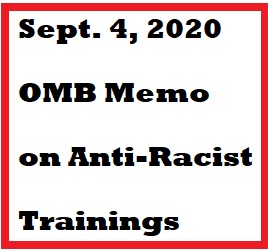
Inaugural Edition
![]()
Opening
Lines of
Communication
with LGBTQ
Youth
A Re-do on
Civil Rights
Thanks to
Black Lives
Matter
Why Critical
Race Theory
Matters
Gloss of Larsen-
Freeman's
Complexity
Theory
Self-
Determination
in Individual
Plans of Study
Questions on
Nuclear Power
from the Pre-
Fukushima Era
Thought
Experiment
to Learn
Action Research
SEE WINTER
EDITION FROM
Nov 2020
to Mar 2021
editor@
Information:
multilingual
adaptive.net
![]()

The Significance of Critical Race Theory
A Statement in Favor of Empathy and Understanding
The administration announced its intention to restrict federal funding of trainings on "Critical Race Theory" and "White Privilege," while labeling these conceptual frameworks as "anti-American." There are many researchers far more qualified than me to take up the gauntlet the administration has thrown down in announcing its new policy. But I cannot remain silent. Two of my most influential professors from courses I took over a decade ago in my doctoral program -- Dr. BeEtta Stoney and Dr. Kay Ann Taylor -- who taught me "Multicultural Curriculum Restructuring" and "Philosophy of Education" -- made sure that I understood the relevance of critical race theory and white privilege. They would expect me to do nothing less than to respond to the administration's provocative statement. The following is a pertinent section from my dissertation thesis on multicultural special education.
McCray et al. (2007) wonder “whether or not any lingering thought pattern as it relates to race relations
pre-Brown (i.e., institutional racism and White privilege)...is being manifested in the wide disparities
observed in the selection and placement of African American secondary school principals” (p. 250).
McCray et al. explore this concern from within the context of an analytical tool, mentioned also
in reference to research by Moore et al. (2008) earlier in the present study, called “Critical Race
Theory” (CRT), which, according to McCray et al., “requires the acknowledgement of the role that race
has played in our society.... [and] advocates policies to ensure that individuals who have been
historically disenfranchised are given equal access to opportunities...in educational leadership, a field
that has been overwhelmingly dominated by White men” (p. 250).
Critical Race Theory is a form of analysis that began in the study of law and, in recent decades,
has been applied to education, providing a way of understanding and expressing the continuing
influence of racism—especially institutional racism—on the rights, opportunities, and experiences of
Americans today. “Understanding the permanence of racism is critical in examining the placement of
African American principals in this designated southeastern state, because of the state's historical
legacy of racism,” according to McCray et al. (2007, p. 250).
Ladson-Billings and Tate (1995) explained the importance of anecdotal evidence in using
Critical Race Theory as an analytical tool. “For the critical race theorist,” they write, “social reality is
constructed by the formulation and the exchange of stories about individual situations. These stories
serve as interpretive structures by which we impose order on experience and it on us” (p. 57). Telling
ones own story provides a path to escape and subvert rhetorical traditions which have served to oppress
certain groups, according to those authors.
Another aspect of Critical Race Theory is the understanding and analysis of white privilege, and
its origins in the traditions of property law. “More pernicious and long lasting than the victimization of
people of color is the construction of whiteness as the ultimate property,” write Ladson-Billings and
Tate (p. 58). This social and historical phenomenon is explained by Harris (1993).
“The concept of Whiteness as property within the American educational system,” explain
McCray et al. (2007), “requires that some form of inquiry take place with regard to how we select and
place African American administrators” (p. 252).
Navigating a Social Maze
An implication of these findings regarding preferential treatment of white administrators is that
young blacks who aspire to be teachers and educational leaders must navigate a social maze very
different from what their white peers will encounter. A case is made that teacher educators and others in
the educational system, from high school counselors to college deans, acknowledge and respond to the
historical and present reality in American society of whiteness as property which conveys privileges
(Harris, 1993; McCray et al.. 2007; Ladson-Billings and Tate, 1995).
Harris (1993) cited the following
description by Underkuffler (1990) to illustrate the expansive concept of property in early America,
which:
One real challenge of post-secondary transition for African American students and the responsible
adults in their lives is to present opportunities and experiences which empower these young people to
fully enjoy all of the freedoms listed above.
Reprinted from pp. 63-66 in "Do Kansas Schools Address Multicultural Needs of Exceptional Students in Transition Practices? A Survey of Special Educators in Grades 9-12 with Direct Experience in Transition Planning for Culturally and/or Linguistically Diverse Students" (Scott, 2011, ProQuest).
2020 The Multilingual Adaptive Systems Newsletter

A second reason for the naming-one's-own-reality theme of
critical race theory is the psychic preservation of marginalized
groups. A factor contributing to the demoralization of marginalized
groups is self-condemnation. Members of minority groups internalize
the stereotypic images that certain elements of society have constructed
in order to maintain their power. Historically, storytelling has been a
kind of medicine to heal the wounds of pain caused by racial
oppression. The story of one's condition leads to realization of how
one came to be oppressed and subjugated and allows one to stop
inflicting mental violence on oneself.
(Ladson-Billings & Tate, 1995, p. 57)
Slavery as a system of property facilitated the merger of white
identity and property. Because the system of slavery was contingent
on and conflated with racial identity, it became crucial to be “white,”
to be identified as white, to have the property of being white. Whiteness
was the characteristic, the attribute, the property of free human beings....
(Harris, 1993, p. 279)
Unless university leadership preparation programs acknowledge
the historical and current role of race in our society and in the
field of educational leadership, there will continue to be an
underlying supposition within the field of education that
minority principals should only be placed and can only
lead in schools with a heavy concentration of minority
students.
(McCray et al., 2007, p. 253)
included not only external objects and people's relationships to
them, but also all of those human rights, liberties, powers, and
immunities that are important for human well-being, including
freedom of expression, freedom of conscience, freedom from
bodily harm, and free and equal opportunities to use personal
faculties.
(Underkuffler, L.S., 1990, p. 129)
Report by Robb Scott
editor@multilingualadaptive.net